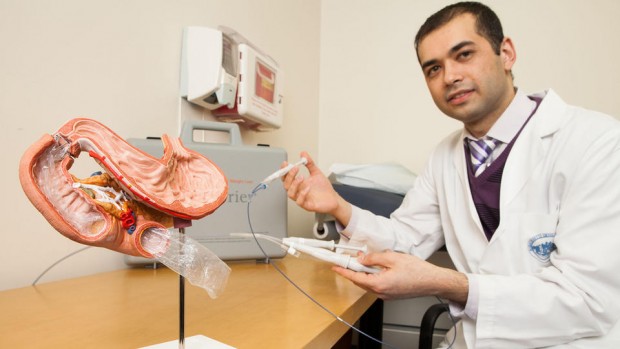Weight loss surgery falls into three main categories. The first is known as malabsorption surgery and is based upon the principally of allowing the patient to continue to eat normally and then re-routing food through the digestive system so that the body is able to absorb only a small fraction of the calorific value of the food eaten. The second is referred to as restrictive surgery in which the patient’s stomach is drastically reduced in size and the quantity of food which the patient can eat, and consequently the number of calories that the body can adsorb, is severely restricted. The third category of surgery is simply a mixture of the first two providing for both a restricted intake and poor calorific absorption.
Biliopancreatic diversion (BPD) is a modern improvement on early attempts at malabsorption surgery and was pioneered by Professor Nicola Scopinaro at the University of Genoa. Biliopancreatic diversion is also sometimes referred to as the Scopinaro procedure.
The first part of the procedure involves the removal of a section of the stomach in order to reduce the quantity of food that the patient can eat. In the case of BPD however the remaining section of stomach is considerably bigger than that seen in restrictive surgery and patients are still able to eat large quantities of food. While it could be argued that BPD should be classed as a mixed procedure, the restrictive element here is very much secondary to the remainder of the procedure.
The second part of the procedure involves the construction of a long limb to join the stomach to the lower portion of the small intestine leaving a short common channel for the re-routed new digestive path and the newly bypassed upper small intestine, which includes both the duodenum and the jejunum.
Although BPD has proved very effective in terms of weight loss, and shows good weight loss maintenance many years after surgery for the majority of patients, the malasorptive element of the operation is so potent that it often leads to a serious problem of protein malnutrition.
As a result, biliopancreatic diversion is rarely used today and has been largely replaced by a procedure developed by Dr Hess in 1988 which takes Scopinaro’s procedure and combines it with a duodenal switching procedure described by Dr DeMeester in 1987. The resultant hybrid operation, known as a biliopancreatic diversion with duodenal switch (BPDDS) allows part of the duodenum to remain in the digestive tract and reduces many of nutritional problems seen in the original BPD procedure. The reduced malabsorption effects of the BPDDS are also countered by a more radical form of gastrectomy creating a sleeve along the natural curvature of the stomach which reduces the effective size of the stomach further and moves BPDDS into the class of mixed weight loss surgical procedures.
Biliopancreatic diversion with duodenal switch is a popular and widely used form of surgery today but it is also one of the most complex forms of weight loss surgery. Consequently, anyone contemplating this particular route should seek out a highly experienced surgeon and should ensure that there is a good life-long follow-up program in place.






